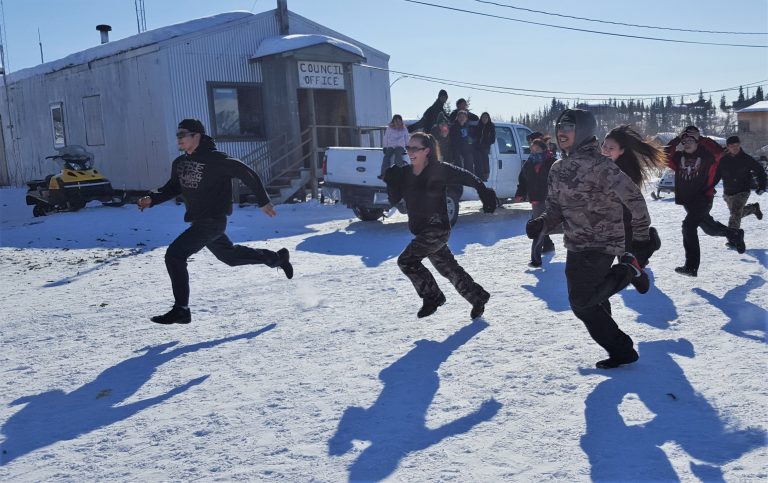Participants run a race at the Spring Carnival in Arctic Village. Photo by Megan Corazza.
Marvin, the airport cat in Fort Yukon, sat on the table and stared unnervingly for hours at my former college ski coach, Eli Brown, as we waited for the weather to break. When the April blizzard gave way to blue sky, our plane took off towards the East Fork of the Chandalar River where Vashraii K’oo (the Gwich’in name of Arctic Village) was perched on its banks. We hauled bags of ski equipment towards the school, and noticed a banner across the main road that said “Welcome to Arctic Village Spring Carnival.” Little did we know that we had arrived just in time for an unforgettable celebration.
Caribou, and the way of life built around them, were the main features of Spring Carnival. Every day in the center of the village there was a community-wide potlatch. Locals built a fire and slowly twirled caribou heads, skinned and hung on forked sticks, over the coals all day. Men would take turns tending the fire and slowly walking from line to line, twirling each between their fingers and creating a vertical rotisserie effect.

When it was time for potlatch, most of the 150 residents gathered. Visitors from Venetie and other villages arrived by bush plane or 100-mile snowmachine trips. A crowd donning Carhartt bibs and fur hats surrounded the platters of freshly cooked caribou meat. A prayer of thanks was said and then guests were always served first, followed by elders. I found myself sitting on a bowed plank set between two log rounds, savoring the tender meat of a jawbone and tongue while dodging the rush to the tables that erupted when they announced that the eyeballs were ready.
During the day, games filled the center of the village. Quite often, wiry, athletic hunters would pull in towing a sled filled with several freshly harvested caribou, shut off their snowmachines, and walk over to join the fun. There was a caribou head-skinning competition, with men’s and women’s divisions. The fastest skinner would slam down their knife and hold up the head to claim victory. These heads would be served in the potlatch the next day. A similar event was held to award the people who could skin the lower leg the fastest. In another contest, each person got a hammer and 10 nails, and the first one to get all 10 nails driven into a thick timber received an envelope with prize money. Egg-toss competitions left the road covered in yolk splatters, and one pair of older men wowed the crowd as they tossed their egg up and over the carnival banner in an impressive display of finesse. Racers touched their foreheads to sticks, spun around to the count of 20, and had the crowd roaring with laughter as they tried to get to the finish line in the dizzy-stick race.
Late one night, when the spring sun finally went down, a game of village-wide BINGO started. Instead of playing in a common hall, they gathered in their own houses and played by VHF radio. 4-wheelers went house to house to distribute prizes and new BINGO cards. We were invited in by the crackling fire at the Tritt’s house to watch the fervor of pages being flipped through at lightning speed and filling up with colored dots. Dried caribou meat was occasionally pulled down from ceiling racks to munch on during the game. A visitor from Fort Yukon gave me his booklet to play and I broke a sweat trying to keep up with the speed of everyone else at the table. When the heat of the house and pressure became too intense, one woman beckoned for us to go outside with her. The northern lights danced overhead, and she explained that you can bend them with a whistle, and that is how they used to find lost hunters. When someone didn’t come back from a day of hunting, the rest of the village would stand outside and watch which way the northern lights bent, and that’s where the hunters would be. I will admit to skepticism, until we stood there and watched a huge arc of green and orange bend straight towards her as she whistled. The muffled VHF and occasional cheer rose from within the cabin behind us and the aurora almost seemed to brush the top of the roofs.

On the final night, a dance was held at the community hall. A giant barrel stove stood in the corner of the room, and benches lined the walls. Little girls ran around in snow boots and sleeveless dresses, and coats were hung on pegs. A woman stood up and addressed the crowd. Her words were succinct: “Spring Carnival is a celebration that we have all survived another winter together.” As Trimble Gilbert (an Episcopal priest and tribal leader) and the rest of the Athabascan fiddle players started up, couples began jigging across the wooden floor to whistles and clapping. They danced in circles, they danced in squares, they danced away the darkness and isolation of another brutal winter in the foothills of the Brooks Range. They danced all night.


Comments are closed.